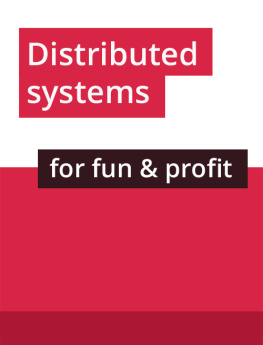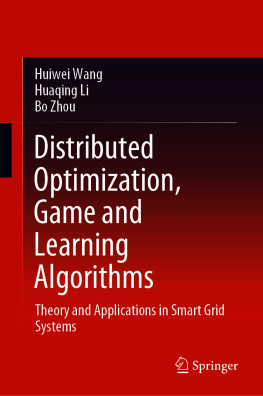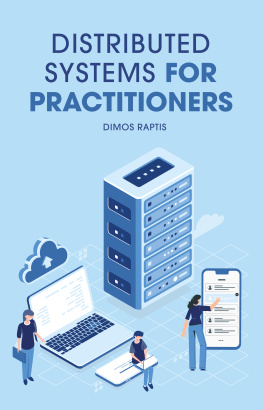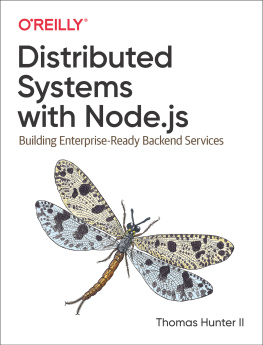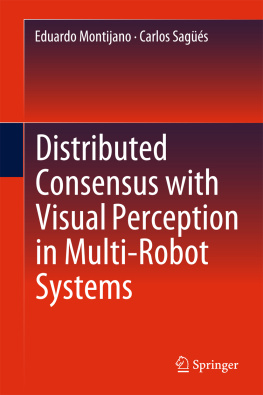Mikito Takada - Distributed systems for fun and profit
Here you can read online Mikito Takada - Distributed systems for fun and profit full text of the book (entire story) in english for free. Download pdf and epub, get meaning, cover and reviews about this ebook. genre: Computer. Description of the work, (preface) as well as reviews are available. Best literature library LitArk.com created for fans of good reading and offers a wide selection of genres:
Romance novel
Science fiction
Adventure
Detective
Science
History
Home and family
Prose
Art
Politics
Computer
Non-fiction
Religion
Business
Children
Humor
Choose a favorite category and find really read worthwhile books. Enjoy immersion in the world of imagination, feel the emotions of the characters or learn something new for yourself, make an fascinating discovery.
- Book:Distributed systems for fun and profit
- Author:
- Genre:
- Rating:5 / 5
- Favourites:Add to favourites
- Your mark:
- 100
- 1
- 2
- 3
- 4
- 5
Distributed systems for fun and profit: summary, description and annotation
We offer to read an annotation, description, summary or preface (depends on what the author of the book "Distributed systems for fun and profit" wrote himself). If you haven't found the necessary information about the book — write in the comments, we will try to find it.
Distributed systems for fun and profit — read online for free the complete book (whole text) full work
Below is the text of the book, divided by pages. System saving the place of the last page read, allows you to conveniently read the book "Distributed systems for fun and profit" online for free, without having to search again every time where you left off. Put a bookmark, and you can go to the page where you finished reading at any time.
Font size:
Interval:
Bookmark:
for fun and profit
I wanted a text that would bring together the ideas behind many of the more recent distributed systems - systems such as Amazon's Dynamo, Google's BigTable and MapReduce, Apache's Hadoop and so on.
In this text I've tried to provide a more accessible introduction to distributed systems. To me, that means two things: introducing the key concepts that you will need in order to have a good time reading more serious texts, and providing a narrative that covers things in enough detail that you get a gist of what's going on without getting stuck on details. It's 2013, you've got the Internet, and you can selectively read more about the topics you find most interesting.
In my view, much of distributed programming is about dealing with the implications of two consequences of distribution:
- that information travels at the speed of light
- that independent things fail independently*
In other words, that the core of distributed programming is dealing with distance (duh!) and having more than one thing (duh!). These constraints define a space of possible system designs, and my hope is that after reading this you'll have a better sense of how distance, time and consistency models interact.
This text is focused on distributed programming and systems concepts you'll need to understand commercial systems in the data center. It would be madness to attempt to cover everything. You'll learn many key protocols and algorithms (covering, for example, many of the most cited papers in the discipline), including some new exciting ways to look at eventual consistency that haven't still made it into college textbooks - such as CRDTs and the CALM theorem.
I hope you like it! If you want to say thanks, follow me on Github (or Twitter). And if you spot an error, file a pull request on Github.
covers distributed systems at a high level by introducing a number of important terms and concepts. It covers high level goals, such as scalability, availability, performance, latency and fault tolerance; how those are hard to achieve, and how abstractions and models as well as partitioning and replication come into play.
dives deeper into abstractions and impossibility results. It starts with a Nietzsche quote, and then introduces system models and the many assumptions that are made in a typical system model. It then discusses the CAP theorem and summarizes the FLP impossibility result. It then turns to the implications of the CAP theorem, one of which is that one ought to explore other consistency models. A number of consistency models are then discussed.
A big part of understanding distributed systems is about understanding time and order. To the extent that we fail to understand and model time, our systems will fail. discusses time and order, and clocks as well as the various uses of time, order and clocks (such as vector clocks and failure detectors).
The introduces the replication problem, and the two basic ways in which it can be performed. It turns out that most of the relevant characteristics can be discussed with just this simple characterization. Then, replication methods for maintaining single-copy consistency are discussed from the least fault tolerant (2PC) to Paxos.
The discussed replication with weak consistency guarantees. It introduces a basic reconciliation scenario, where partitioned replicas attempt to reach agreement. It then discusses Amazon's Dynamo as an example of a system design with weak consistency guarantees. Finally, two perspectives on disorderly programming are discussed: CRDTs and the CALM theorem.
covers recommendations for further reading.
*: This is a lie. This post by Jay Kreps elaborates.
Distributed programming is the art of solving the same problem that you can solve on a single computer using multiple computers.
There are two basic tasks that any computer system needs to accomplish:
- storage and
- computation
Distributed programming is the art of solving the same problem that you can solve on a single computer using multiple computers - usually, because the problem no longer fits on a single computer.
Nothing really demands that you use distributed systems. Given infinite money and infinite R&D time, we wouldn't need distributed systems. All computation and storage could be done on a magic box - a single, incredibly fast and incredibly reliable system that you pay someone else to design for you.
However, few people have infinite resources. Hence, they have to find the right place on some real-world cost-benefit curve. At a small scale, upgrading hardware is a viable strategy. However, as problem sizes increase you will reach a point where either the hardware upgrade that allows you to solve the problem on a single node does not exist, or becomes cost-prohibitive. At that point, I welcome you to the world of distributed systems.
It is a current reality that the best value is in mid-range, commodity hardware - as long as the maintenance costs can be kept down through fault-tolerant software.
Computations primarily benefit from high-end hardware to the extent to which they can replace slow network accesses with internal memory accesses. The performance advantage of high-end hardware is limited in tasks that require large amounts of communication between nodes.
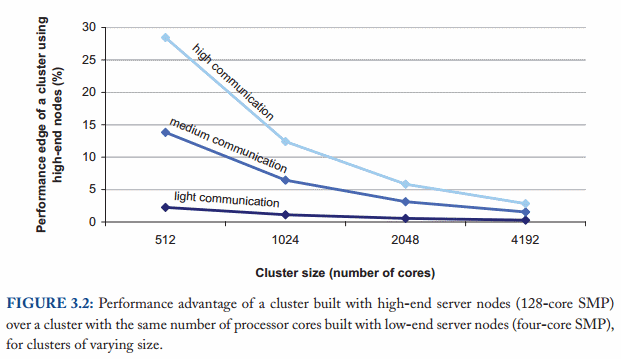
As the figure above from Barroso, Clidaras & Hlzle shows, the performance gap between high-end and commodity hardware decreases with cluster size assuming a uniform memory access pattern across all nodes.
Ideally, adding a new machine would increase the performance and capacity of the system linearly. But of course this is not possible, because there is some overhead that arises due to having separate computers. Data needs to be copied around, computation tasks have to be coordinated and so on. This is why it's worthwhile to study distributed algorithms - they provide efficient solutions to specific problems, as well as guidance about what is possible, what the minimum cost of a correct implementation is, and what is impossible.
The focus of this text is on distributed programming and systems in a mundane, but commercially relevant setting: the data center. For example, I will not discuss specialized problems that arise from having an exotic network configuration, or that arise in a shared-memory setting. Additionally, the focus is on exploring the system design space rather than on optimizing any specific design - the latter is a topic for a much more specialized text.
The way I see it, everything starts with the need to deal with size.
Most things are trivial at a small scale - and the same problem becomes much harder once you surpass a certain size, volume or other physically constrained thing. It's easy to lift a piece of chocolate, it's hard to lift a mountain. It's easy to count how many people are in a room, and hard to count how many people are in a country.
So everything starts with size - scalability. Informally speaking, in a scalable system as we move from small to large, things should not get incrementally worse. Here's another definition:
Scalabilityis the ability of a system, network, or process, to handle a growing amount of work in a capable manner or its ability to be enlarged to accommodate that growth.Font size:
Interval:
Bookmark:
Similar books «Distributed systems for fun and profit»
Look at similar books to Distributed systems for fun and profit. We have selected literature similar in name and meaning in the hope of providing readers with more options to find new, interesting, not yet read works.
Discussion, reviews of the book Distributed systems for fun and profit and just readers' own opinions. Leave your comments, write what you think about the work, its meaning or the main characters. Specify what exactly you liked and what you didn't like, and why you think so.

